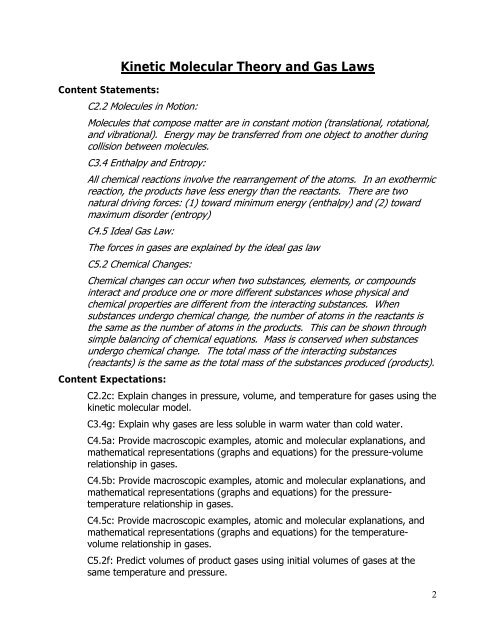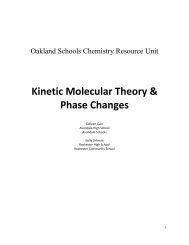Kinetic Molecular Theory Gas Laws - Oakland Schools
Kinetic Molecular Theory Gas Laws - Oakland Schools
Kinetic Molecular Theory Gas Laws - Oakland Schools
You also want an ePaper? Increase the reach of your titles
YUMPU automatically turns print PDFs into web optimized ePapers that Google loves.
Content Statements:<br />
<strong>Kinetic</strong> <strong>Molecular</strong> <strong>Theory</strong> and <strong>Gas</strong> <strong>Laws</strong><br />
C2.2 Molecules in Motion:<br />
Molecules that compose matter are in constant motion (translational, rotational,<br />
and vibrational). Energy may be transferred from one object to another during<br />
collision between molecules.<br />
C3.4 Enthalpy and Entropy:<br />
All chemical reactions involve the rearrangement of the atoms. In an exothermic<br />
reaction, the products have less energy than the reactants. There are two<br />
natural driving forces: (1) toward minimum energy (enthalpy) and (2) toward<br />
maximum disorder (entropy)<br />
C4.5 Ideal <strong>Gas</strong> Law:<br />
The forces in gases are explained by the ideal gas law<br />
C5.2 Chemical Changes:<br />
Chemical changes can occur when two substances, elements, or compounds<br />
interact and produce one or more different substances whose physical and<br />
chemical properties are different from the interacting substances. When<br />
substances undergo chemical change, the number of atoms in the reactants is<br />
the same as the number of atoms in the products. This can be shown through<br />
simple balancing of chemical equations. Mass is conserved when substances<br />
undergo chemical change. The total mass of the interacting substances<br />
(reactants) is the same as the total mass of the substances produced (products).<br />
Content Expectations:<br />
C2.2c: Explain changes in pressure, volume, and temperature for gases using the<br />
kinetic molecular model.<br />
C3.4g: Explain why gases are less soluble in warm water than cold water.<br />
C4.5a: Provide macroscopic examples, atomic and molecular explanations, and<br />
mathematical representations (graphs and equations) for the pressure-volume<br />
relationship in gases.<br />
C4.5b: Provide macroscopic examples, atomic and molecular explanations, and<br />
mathematical representations (graphs and equations) for the pressuretemperature<br />
relationship in gases.<br />
C4.5c: Provide macroscopic examples, atomic and molecular explanations, and<br />
mathematical representations (graphs and equations) for the temperaturevolume<br />
relationship in gases.<br />
C5.2f: Predict volumes of product gases using initial volumes of gases at the<br />
same temperature and pressure.<br />
2
















